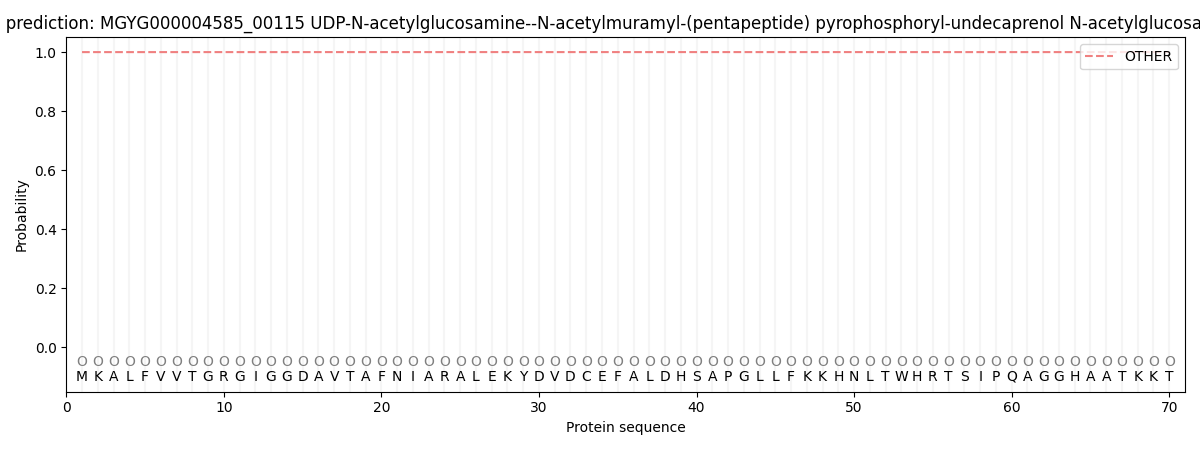You are browsing environment: HUMAN GUT
CAZyme Information: MGYG000004585_00115
You are here: Home > Sequence: MGYG000004585_00115
Basic Information |
Genomic context |
Full Sequence |
Enzyme annotations |
CAZy signature domains |
CDD domains |
CAZyme hits |
PDB hits |
Swiss-Prot hits |
SignalP and Lipop annotations |
TMHMM annotations
Basic Information help
| Species | Methanobacterium sp000499765 | |||||||||||
|---|---|---|---|---|---|---|---|---|---|---|---|---|
| Lineage | Archaea; Methanobacteriota; Methanobacteria; Methanobacteriales; Methanobacteriaceae; Methanobacterium; Methanobacterium sp000499765 | |||||||||||
| CAZyme ID | MGYG000004585_00115 | |||||||||||
| CAZy Family | GT28 | |||||||||||
| CAZyme Description | UDP-N-acetylglucosamine--N-acetylmuramyl-(pentapeptide) pyrophosphoryl-undecaprenol N-acetylglucosamine transferase | |||||||||||
| CAZyme Property |
|
|||||||||||
| Genome Property |
|
|||||||||||
| Gene Location | Start: 107055; End: 108104 Strand: - | |||||||||||
CDD Domains download full data without filtering help
| Cdd ID | Domain | E-Value | qStart | qEnd | sStart | sEnd | Domain Description |
|---|---|---|---|---|---|---|---|
| cd17507 | GT28_Beta-DGS-like | 6.99e-08 | 162 | 277 | 173 | 291 | beta-diglucosyldiacylglycerol synthase and similar proteins. beta-diglucosyldiacylglycerol synthase (processive diacylglycerol beta-glucosyltransferase EC 2.4.1.315) is involved in the biosynthesis of both the bilayer- and non-bilayer-forming membrane glucolipids. This family of glycosyltransferases also contains plant major galactolipid synthase (chloroplastic monogalactosyldiacylglycerol synthase 1 EC 2.4.1.46). Glycosyltransferases catalyze the transfer of sugar moieties from activated donor molecules to specific acceptor molecules, forming glycosidic bonds. The acceptor molecule can be a lipid, a protein, a heterocyclic compound, or another carbohydrate residue. The structures of the formed glycoconjugates are extremely diverse, reflecting a wide range of biological functions. The members of this family share a common GTB topology, one of the two protein topologies observed for nucleotide-sugar-dependent glycosyltransferases. GTB proteins have distinct N- and C- terminal domains each containing a typical Rossmann fold. The two domains have high structural homology despite minimal sequence homology. The large cleft that separates the two domains includes the catalytic center and permits a high degree of flexibility. |
| COG0707 | MurG | 2.33e-07 | 6 | 342 | 4 | 351 | UDP-N-acetylglucosamine:LPS N-acetylglucosamine transferase [Cell wall/membrane/envelope biogenesis]. |
| cd03785 | GT28_MurG | 7.38e-07 | 73 | 341 | 69 | 350 | undecaprenyldiphospho-muramoylpentapeptide beta-N-acetylglucosaminyltransferase. MurG (EC 2.4.1.227) is an N-acetylglucosaminyltransferase, the last enzyme involved in the intracellular phase of peptidoglycan biosynthesis. It transfers N-acetyl-D-glucosamine (GlcNAc) from UDP-GlcNAc to the C4 hydroxyl of a lipid-linked N-acetylmuramoyl pentapeptide (NAM). The resulting disaccharide is then transported across the cell membrane, where it is polymerized into NAG-NAM cell-wall repeat structure. MurG belongs to the GT-B structural superfamily of glycoslytransferases, which have characteristic N- and C-terminal domains, each containing a typical Rossmann fold. The two domains have high structural homology despite minimal sequence homology. The large cleft that separates the two domains includes the catalytic center and permits a high degree of flexibility. |
| cd04951 | GT4_WbdM_like | 8.64e-04 | 211 | 278 | 215 | 291 | LPS/UnPP-GlcNAc-Gal a-1,4-glucosyltransferase WbdM and similar proteins. This family is most closely related to the GT4 family of glycosyltransferases and is named after WbdM in Escherichia coli. In general glycosyltransferases catalyze the transfer of sugar moieties from activated donor molecules to specific acceptor molecules, forming glycosidic bonds. The acceptor molecule can be a lipid, a protein, a heterocyclic compound, or another carbohydrate residue. This group of glycosyltransferases is most closely related to the previously defined glycosyltransferase family 1 (GT1). The members of this family may transfer UDP, ADP, GDP, or CMP linked sugars. The diverse enzymatic activities among members of this family reflect a wide range of biological functions. The protein structure available for this family has the GTB topology, one of the two protein topologies observed for nucleotide-sugar-dependent glycosyltransferases. GTB proteins have distinct N- and C- terminal domains each containing a typical Rossmann fold. The two domains have high structural homology despite minimal sequence homology. The large cleft that separates the two domains includes the catalytic center and permits a high degree of flexibility. The members of this family are found in bacteria. |
| PRK00726 | murG | 0.001 | 73 | 348 | 71 | 357 | undecaprenyldiphospho-muramoylpentapeptide beta-N- acetylglucosaminyltransferase; Provisional |
CAZyme Hits help
| Hit ID | E-Value | Query Start | Query End | Hit Start | Hit End |
|---|---|---|---|---|---|
| CDG64389.1 | 1.65e-244 | 1 | 349 | 1 | 349 |
| AXV39809.1 | 2.52e-223 | 1 | 349 | 1 | 349 |
| CEA12559.1 | 3.58e-223 | 1 | 349 | 1 | 349 |
| AIS32806.1 | 3.58e-223 | 1 | 349 | 1 | 349 |
| CEL23985.1 | 3.58e-223 | 1 | 349 | 1 | 349 |
Swiss-Prot Hits help
SignalP and Lipop Annotations help
This protein is predicted as OTHER

| Other | SP_Sec_SPI | LIPO_Sec_SPII | TAT_Tat_SPI | TATLIP_Sec_SPII | PILIN_Sec_SPIII |
|---|---|---|---|---|---|
| 1.000019 | 0.000000 | 0.000000 | 0.000000 | 0.000000 | 0.000000 |
